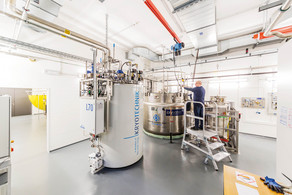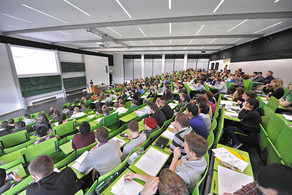Thesis defense of David Mönkebüscher
- Defense
The ferromagnetic semiconductor europium monoxide (EuO) is a promising candidate for new spintronic applications due to its large magnetic moment and strong magnetooptical effects combined with its insulating properties. Although EuO has the highest Curie temperature among the europium chalcogenides with TC = 69 K, it still requires excessive cooling in real applications. Many approaches to increase its TC have been successfully studied, such as doping with Gd ions or epitaxial straining, which inevitably change the stoichiometry and conductivity of the rare earth oxide. An alternative pathway to greatly increase the Curie temperature of EuO while preserving its conductivity and stoichiometry could be based on the magnetic proximity effect. This effect relies on the coupling to a high TC ferromagnet, and has been demonstrated in the literature for similar systems. In this thesis, a EuO/Co bilayer of thin films is studied using the static and timeresolved magneto-optical Kerr effect (MOKE) to find an evidence for an elevated EuO TC due to the proximity to the transition metal Co. Furthermore, the influence of Co on the spin dynamics of EuO is investigated. Static measurements of the EuO/Co bilayer hysteresis reveal an antiferromagnetic coupling between the two ferromagnetic layers. Due to the superposition of the measured signal of both layers, the Co hysteresis exceeds any possible residual EuO contribution to the magneto-optical signal above its bulk TC. Time-resolved MOKE measurements show a transient enhancement of the EuO magnetization. It is still present when the Co layer is selectively photoexcited by tuning the photon energy of the pump beam below the EuO band gap energy. This behavior is attributed to the generation of a superdiffusive spin current of majority electrons upon demagnetizing the Co layer. It propagates towards the EuO layer to populate its 5d states, inducing a similar magnetization enhancement compared to direct photoexcitation of the rare earth oxide. The two layers of the investigated sample system exhibit a contribution to the transient spin dynamics with opposite signs. Therefore, the EuO/Co bilayer provides a system in which the transient magneto-optical Kerr rotation can be tuned by varying external parameters such as the sample temperature, the applied magnetic field and the pump beam fluence. By strongly exciting the Co layer and thus quenching its magnetization, the EuO hysteresis becomes accessible in transient hysteresis measurements. It persists up to a temperature of 300 K, pointing to an experimental evidence for room temperature magnetic order in EuO induced by proximity to Co.








